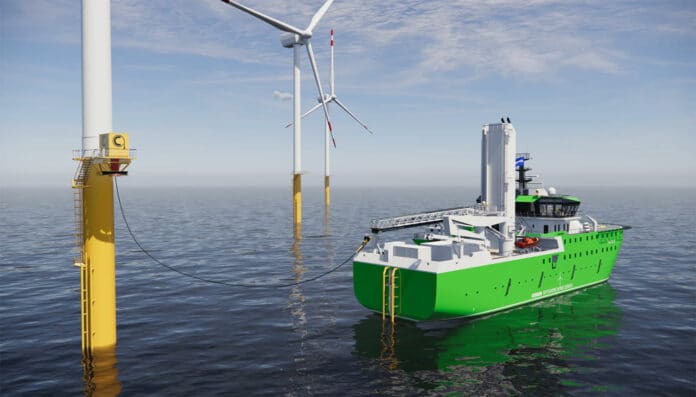Dutch shipbuilder Damen has officially launched its latest vessel, a fully electric Service Operations Vessel (SOV) that can charge offshore. It is an all-electric version of its 70-meter-long hybrid service vessel designed specifically to support offshore wind farm operations. With its offshore charging capabilities, the vessel paves the way for significantly reduced emissions in the maintenance of offshore wind farms.
The new SOV 7017 E is an electric vessel that measures 70 meters (230 feet) in length and 17 meters (56 feet) in width. The company says this makes it the largest fully electric offshore wind SOV specifically meant for maintenance purposes. It also comes with two HVO or diesel generators, but these are intended to serve as a backup in case of any emergency.
With 60 cabins for crew and 40 technicians, the vessel is well-equipped with storage space, workshops, and deck space to undertake the broad scope of transportation and work expected of it.
One of the most impressive features of the 7017 E is its advanced battery system. It comes with a 15-MWh Lithium Iron Phosphate battery system, which allows for an estimated 98% of all-day full electric operations, or a 10-MWh battery bank for 75% electric operations. The propulsion system comprises of four 900-kW azimuth thrusters arranged in a double-ended configuration, which helps to achieve a top speed of 12 knots (22 km/h).
Damen started exploring the feasibility of an electric SOV three years ago to make vessel operations at offshore wind farms more sustainable. To achieve offshore charging, Damen has partnered with UK-based MJR Power & Automation – a company that has previously developed an offshore charging system for a crew transfer vessel.
The novel offshore charging solution uses the vessel’s motion-compensated gangway to create a connection between the vessel and a wind turbine or substation offshore. It allows the battery to be charged at sea via a 4MW charger connector, sufficient for a 70-metre vessel. The charging occurs in a low-power ‘green’ DP mode, ensuring energy efficiency.
The company has estimated that a single turbine has the capability to fully charge the vessel’s battery in just a few hours. Although wind turbines and offshore substations will need to have offshore charging stations installed, of course, existing offshore infrastructure can be utilized for this purpose.
The gangway is controlled from the wheelhouse, requiring no manual interaction with charging equipment. Currently, MJR is working on a scaled-up 8MW offshore charging system, which will enable larger vessels up to 90 meters.
“The product launch of the SOV 7017 E demonstrates that the technology is there to make offshore operations fully electric,” said Mark Couwenberg, Damen Product Manager Service Operations Vessel. “The reduction in OPEX implied by harvesting energy directly from the offshore wind farm implies a business case for this model. We cannot do this alone, however. Making this a reality will require collaboration throughout the chain, with the shipbuilder, vessel operator, and wind farm developer working together in pursuit of mutual benefit. We’re looking forward to participating in such cooperation as we take this concept forward. Together, we can make our offshore energy production more sustainable.”
